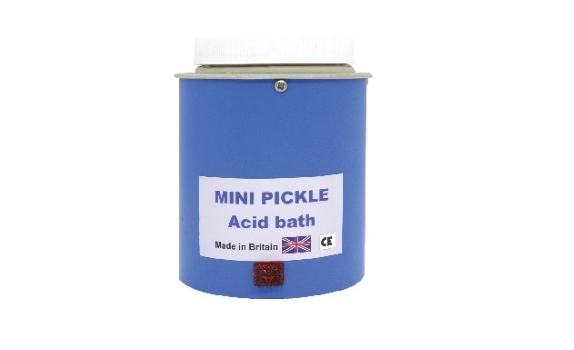Step away from the Kilner jars and put down that beetroot!
Tempting though it is, we are not about to explore the fascinating subject of preserves and chutneys! No, in jewellery terms pickling refers to the process of removing oxidised surfaces and flux from metal after soldering. What is pickling solution made from? It is an acid compound usually made using a specialised pickling powder or liquid pickle solution. So if you use heat and metal, it is essential that you set up a pickle pot.
How to make pickle for jewellery making purposes
Pickle is available in powder or liquid form and normally needs to be diluted with water. Most safety pickles have a base of sulphuric acid but nitric acid can also be used. It is also possible to use some household products such as white vinegar; you just need to work out what will work best for you. All of these metal pickling options work in a similar way with varying degrees ferocity depending on the ratio of water to acid, but it is worth considering what you are happy to have in your home or workshop. Care must always be taken when conducting acid pickling procedures, but storage and disposal are equally as important especially if you have small children or pets.
How to set up a pickle pot step by step
- Clean out a ceramic or glass pot and fill with clean water (if you know your water supply has a high level of minerals in it, it may be best to us distilled water).
- Add your chosen pickle acid to the water. Always read the label and use as instructed.
- Always add acid to water and not the other way around.
- Gently heat the pickle solution to speed up the cleaning process, keeping a consistent heat (most jewellers use a hot plate or slow cooker). Do not allow the solution to boil.
- Place your metal items into the acid pickling solution using either plastic or brass tweezers. Pickle is easily contaminated if certain metals come into contact, most noticeably iron. If this starts to occur, discard the solution and mix up a fresh batch.
- Once your jewellery has been cleaned sufficiently, remove from the pickle solution and rinse under running water. (I find pumice powder and a toothbrush extremely effective for removing any traces of residue and ensuring a really clean, bright surface)
Non-Toxic Pickling Solutions Recipes
- Dissolve 1 tablespoon of alum with 60ml water.
- Combine water with distilled white vinegar and heat in a saucepan to simmering point. At this stage add salt. (approx. 1 part salt to 8 parts vinegar)
Precautions
- Always store acidic compounds in a clearly marked container away from children and pets
- When heating a pickle solution ensure the mixture doesn’t boil.
- Take fire precautions.
- Keep pickling acid away from skin and eyes.
- Dispose of used safety pickle correctly. (Neutralise with bicarbonate of soda first, but check local regulations first)
Find a complete pickling set at Cooksongold and discover how to get a professional finish to your precious metal pieces using our advice above.
Once pickling has been successfully completed you are then ready to start the polishing process…..

Cooksongold

